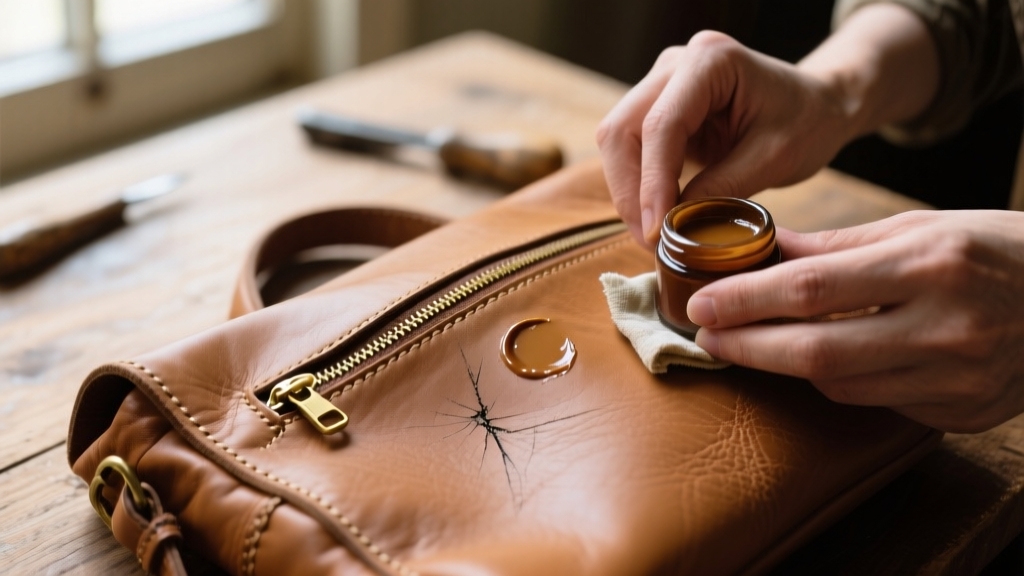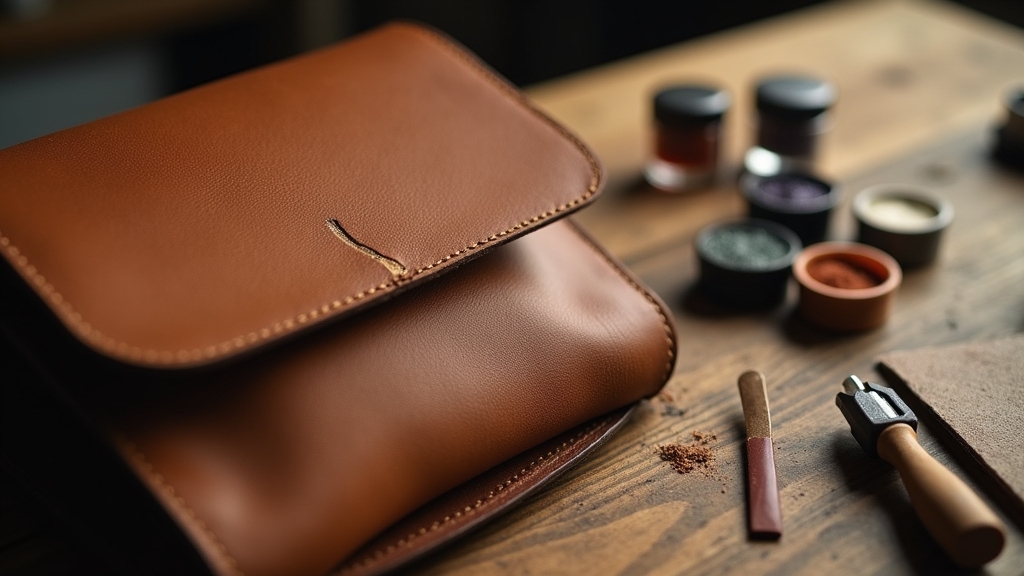
To fix a leather bag scratch, start by gently cleaning the area with a damp cloth or leather cleaner to remove dirt. Condition the leather to soften and reduce light scratches. For minor marks, rub a bit of Vaseline overnight and buff it off.
For deeper scratches, use a leather repair kit with filler and color matching for a seamless look. Finish by applying a protective sealant. If you want to restore your bag fully, there are more precise repair and prevention tips you can apply.
Key Takeaways
- Clean the scratched area gently with a soft cloth and suitable leather cleaner to remove dirt before repair.
- For superficial scratches, rub Vaseline or light oil in circular motions and allow it to absorb overnight.
- Use a color-matched leather marker or recoloring cream in thin layers to blend scratches seamlessly.
- For deep scratches, apply a backing patch and use professional leather repair kits with fillers and color dyes.
- Finish by sanding lightly, conditioning the leather, and applying protective sealants to prevent future damage.
Cleaning and Preparing the Scratched Leather Surface
Before you start repairing scratches on your leather bag, it’s essential to clean and prepare the affected area properly. Begin by gently wiping the scratched surface with a soft, damp cloth or a bamboo pad to remove dust and dirt without soaking the leather.
Use a leather cleaner suited to your bag’s leather type: aniline, painted, or vegetable-tanned. Apply it sparingly with a microfiber cloth. Avoid excess moisture to prevent damage or discoloration.
For dry cleaning, a pencil eraser works well to lift dirt without adding moisture. If dirt remains embedded, carefully use a soft wire brush or toothbrush. Always test cleaning products on a hidden spot to check for adverse effects.
It is important to test all products on inconspicuous areas before full application to prevent further damage. After cleaning, let the leather dry completely before moving on. This ensures better adhesion for later repair steps. In urgent situations, avoid using destructive methods that can damage your leather bag irreparably.
Conditioning Leather to Reduce the Appearance of Light Scratches
When you condition your leather bag, you actively restore moisture that helps diminish the visibility of light scratches. Conditioning oils and creams replenish natural oils, soften fibers, and blend abrasions into the surrounding leather.
Since leather is susceptible to scratches, proper conditioning is essential for maintaining its natural elegance. Using a soft cloth can help avoid further damage during application. Applying conditioner with a soft cloth in circular motions and allowing full absorption ensures ideal results.
Repeat applications gradually improve appearance without oversaturating. Regular conditioning every 3-6 months maintains suppleness, color vibrancy, and reduces scratch prominence.
| Conditioning Benefits | Application Tips |
|---|---|
| Moisturizes and softens | Use soft cloth, circular motions |
| Redistributes natural oils | Allow absorption before buffing |
| Restores suppleness | Avoid over-saturation |
| Maintains color vibrancy | Repeat applications as needed |
Using Vaseline and Moisturizers for Superficial Scratches
Although specialized leather conditioners offer targeted care, you can effectively reduce superficial scratches using Vaseline and common household moisturizers. Start by cleaning the scratched area with a mild leather cleaner or diluted white vinegar to remove dirt.
Then, gently rub a small amount of Vaseline or a light oil like olive oil into the scratch with a soft cloth, using circular motions. This fills minor cracks and softens the leather fibers, reducing scratch visibility. Allow it to absorb overnight, applying thin layers if needed. Using proper techniques ensures the leather is treated without causing further damage.
Finally, buff the area with a dry soft cloth to blend the treatment evenly and remove excess product. Always test these remedies on a hidden spot first, as results can vary by leather type and excess oil may darken the surface.
Applying Color-Matched Leather Markers and Recoloring Creams
To fix scratches effectively, the first step is to choose a leather marker or recoloring cream that matches your bag’s original color as closely as possible. Once you’ve got your product, use a sponge to apply the recoloring cream. This way, you’ll ensure even absorption.
It’s best to build up multiple light coats to achieve a smooth finish. Leather soaks in color quickly, so applying thin layers helps achieve even coverage without oversaturating.
Oh, and don’t forget! Before diving into the repair, make sure to test the color on a hidden spot. This little trick helps ensure you get the perfect match before you commit to fixing the scratches.
Choosing Right Color
Because matching the color of your leather bag precisely is essential, you’ll want to select color-matched leather markers or recoloring creams that blend seamlessly with the original hue.
Start by identifying the exact shade of your leather. Markers come in various colors tailored for different tones, ensuring discreet touch-ups. Consider the impact of surface measurements on the application to ensure even coverage.
If you can’t find a perfect match, consider mixing primary colors like black, red, and white, adding pigments such as yellow or ivory to fine-tune the hue. Always test your chosen or mixed color on a hidden spot first to confirm it matches and won’t fade quickly.
To achieve a natural finish, apply multiple layers and use a buffing motion to blend the color smoothly into the leather surface, helping to conceal any minor mismatches and preserving the leather’s texture (Color Matching and Blending).
Applying Recoloring Cream
When you apply recoloring cream to your leather bag, start by thoroughly cleaning and drying the scratched area to guarantee proper adhesion and a smooth finish.
Use a mild leather cleaner or distilled water with a soft cloth, then confirm the area is completely dry. Regular maintenance and cleaning can also help prevent further damage and improve the durability of leather.
Test the cream on a hidden spot first to confirm color match and compatibility. Apply the cream evenly with a small sponge or brush, working gently into the scratch without saturating the leather.
Let it dry for 10–15 minutes before adding more coats if needed, building coverage gradually. Multiple layers help blend the repair with surrounding areas for a more natural look.
Once satisfied, buff lightly with a soft cloth to restore sheen. Finish by sealing the repair with a leather protector to enhance durability and maintain the leather’s natural softness.
Repairing Deep Scratches With Leather Repair Kits

Although deep scratches can seem intimidating, you can effectively restore your leather bag by selecting a repair kit tailored to the damage’s depth and leather type.
Start by evaluating if the scratch penetrates fully; deeper damage needs kits with backing patches and strong adhesives for support. Clean the area thoroughly before repair to ensure adhesion. Using professional-grade fillers ensures long-lasting repair and maintains leather flexibility.
Insert the backing patch beneath the scratch, then apply the repair compound in thin layers, allowing each to dry fully. Make sure to work in a well-lit area to see the scratch clearly and ensure precise application.
Use palette knives to spread fillers evenly, stabilizing small gouges with adhesives like super glue if needed. Choose kits with color-matching dyes to blend the repair seamlessly with your bag’s finish.
Prioritize professional-grade kits for durability, and always test color matches under different lighting before final application.
Techniques for Filling and Smoothing Leather Scratches
To effectively fill and smooth leather scratches, first, you’ll want to choose a filler that matches both the texture and color of your bag. Get this right, as it will make a big difference in how the repair looks.
When you apply the repair compound, do it carefully. You want to make sure it fills the scratch perfectly without overflowing. That way, it won’t create more work for you later on!
After the compound has dried, take a gentle approach to sanding the area. This step is crucial because it helps blend the repair seamlessly with the surrounding leather. Using tools with precision maneuverability can make this step easier and more controlled.
With a little patience, you’ll achieve a flawless finish that makes those scratches a thing of the past! For best results, consider applying leather dye to scratches and worn areas before polishing to restore color consistency and coverage leather dye application.
Choosing Leather Fillers
Selecting the right leather filler plays a crucial role in effectively repairing scratches and restoring your leather item’s appearance. You’ll want to choose a filler based on the damage type. Water-based fillers work well for minor scratches, while flexible fillers like Leather Flexifil suit highly bendable areas, preventing cracking.
If your bag has tears or holes, consider using leather sub patches alongside fillers for added support. Keep in mind that polyurethane-based fillers offer superior durability and elasticity compared to basic PVA products.
For best results, pick a filler compatible with your leather type—real, faux, or vinyl—as each requires specific formulations. Each filler type has specific physical properties designed for different repair needs.
Using proper maintenance techniques can also prolong the life of your repaired leather surface. Ultimately, a quality flexible filler that dries smoothly and can be color-matched will help you achieve a seamless, long-lasting repair that blends with your bag’s original surface.
Applying Leather Repair Compound
When you prepare the leather surface properly, applying the repair compound becomes much more effective and long-lasting. Use a small spatula or plastic card to spread a thin, even layer into the scratch. Follow this approach:
Start at the scratch’s back and work forward to fill it fully. Feather the compound beyond scratch edges for seamless blending. Apply multiple thin layers if needed; avoid thick, uneven coats. Work swiftly yet carefully because most compounds cure quickly.
Guarantee each layer dries before adding the next to prevent cracking. Using a filler made from PA glues and PVC-based elements ensures flexibility once dried, which helps the repair better mimic the original leather’s properties. This method is similar to the precision needed when setting a new 4-digit code to ensure proper alignment and effectiveness.
This technique helps you achieve a smooth, durable fill that integrates well with the leather. Proper application sets a solid foundation for the next step: sanding and smoothing the surface.
Sanding and Smoothing Surface
Although filling the scratch is essential, sanding and smoothing the leather surface guarantees a flawless finish that blends seamlessly with the surrounding area.
Start by cleaning the area to remove dirt. Then, sand gently in the direction of the leather grain using progressively finer grit sandpaper, from 120 to 220. Proper product selection depends on size and depth of damage to leather areas, so choose your materials accordingly.
Avoid heavy pressure to prevent new damage. For suede or nubuck, slightly moisten the area before sanding. After sanding, apply a leather conditioner to restore moisture and soften the surface.
Use a soft cloth to buff the area evenly, paying close attention to edges for a smooth transition. If needed, apply a recoloring product to match the original color. This careful process ensures your leather bag looks natural and scratch-free.
Protective Treatments to Enhance Leather Durability
Because leather is constantly exposed to moisture, friction, and environmental elements, applying protective treatments after repairing scratches is essential to preserve its durability. These treatments create a protective barrier that extends the life of your leather bag while maintaining its appearance.
Consider these key protective steps:
- Use sealants or waterproof sprays to shield leather from moisture and abrasion. Regular cleaning with a soft cloth is also crucial to prevent dirt buildup that can cause surface damage and diminish leather integrity regular cleaning.
- Apply treatments only after repair to lock in the effects and maintain color vibrancy.
- Reapply products regularly based on exposure to ensure continuous protection.
- Combine protective sprays with conditioners to keep leather supple and resilient.
- Avoid over-application to prevent residue buildup that can attract dirt.
Best Practices for Preventing Future Leather Scratches
To keep your leather bag looking pristine, you’ll want to adopt careful handling and storage habits that minimize exposure to potential scratch hazards. Avoid rough surfaces, store your bag upright with soft materials inside, and keep it in a cool, dry place away from direct sunlight.
Regular cleaning with a soft cloth and conditioning helps maintain leather elasticity. Keep sharp objects separate and avoid overstuffing to prevent creases and scratches. Finally, act quickly on new scratches and consider professional help for severe damage.
| Handling | Storage | Maintenance |
|---|---|---|
| Avoid rough surfaces | Upright positioning | Gentle cleaning |
| Separate sharp items | Use soft wraps | Periodic conditioning |
| Don’t overstuff | Cool, dry place | Regular inspection |
| Protect from pets | Stable placement | Use microfiber cloth |
| Avoid direct sun | Avoid humidity | Prompt scratch care |
Frequently Asked Questions
Can I Use Household Items Like Nail Polish to Fix Leather Scratches?
You shouldn’t use nail polish to fix leather scratches because its harsh chemicals can damage and discolor the leather. Instead, try gentle household items like olive oil or colorless shoe polish to blend minor scratches, but always test first on a hidden spot.
For deeper scratches, professional leather repair kits or conditioners are safer and more effective. Avoid nail polish remover entirely; it’ll only worsen the damage and ruin your bag’s finish.
How Long Does It Take for Leather Repair Products to Fully Dry?
Leather repair products usually dry to the touch within 20 to 40 minutes. However, full drying can take up to 24 hours for the best results. Fillers need at least 30 minutes per thin coat. Heavy layers require up to 24 hours to dry completely.
Top coats dry in 2-3 hours but need 8-12 hours to fully cure. To speed things up, use a hair dryer on low heat. But always allow full curing before heavy use.
Are Leather Scratch Repair Methods Safe for Vintage or Antique Bags?
You should be cautious using leather scratch repair methods on vintage or antique bags. Many products can alter delicate finishes or oversaturate brittle leather, causing damage or discoloration.
Instead, prioritize gentle, pH-neutral conditioners designed for old leather and avoid heavy dyes or fillers. Always test on a hidden spot first. For significant scratches, it’s best to consult a professional restorer to preserve your bag’s original texture and value safely.
Can Scratched Leather Bags Be Waterproofed After Repair?
You can absolutely waterproof your leather bag after repairing scratches. It’s like sealing your artwork with a protective glaze. Just make sure the leather is fully dry, cleaned, and conditioned first, so no moisture gets trapped beneath the waterproof layer.
Use leather-specific sprays or waxes, testing on a hidden spot to avoid unwanted color changes. Apply evenly, let it bond, and reapply regularly to keep your bag shielded from future moisture damage.
Is Professional Leather Repair Worth the Cost Compared to DIY Methods?
Professional leather repair is worth the cost when you value quality, durability, and preserving your bag’s appearance, especially for high-end or sentimental items.
You’ll get expert color matching, lasting fixes, and an extended lifespan. DIY methods save money and are fine for minor scratches, but they often require frequent touch-ups and can look patchy.
Keep Your Leather Bag Glowing for Years with the Right Products
Now that you know how to breathe new life into your leather bag, treating scratches won’t feel like a battle anymore. Think of your leather as a canvas; you’re the artist restoring its beauty with each careful touch.
By cleaning, conditioning, and repairing with precision, you’ll smooth out those scars and protect your bag’s story for years to come. Keep these steps in your toolkit, and your leather will age gracefully, shining like the treasure it truly is.
